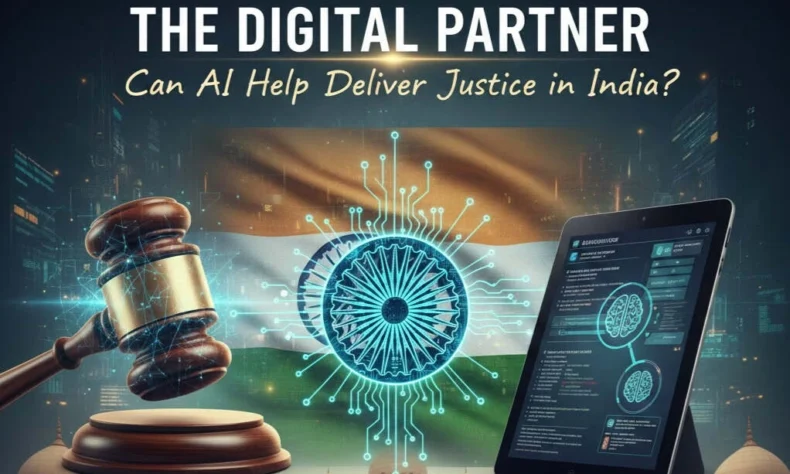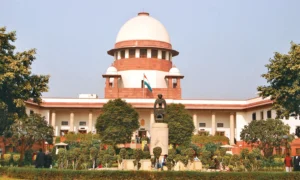
By Samyak Mordia
The scales of Indian justice are famously, and unarguably, overburdened. With crores of cases pending, the journey through our complex and labyrinthine legal system can feel endless, with cases often stretching across decades, a reality that tests the patience of ordinary citizens and clogs the wheels of progress. On the streets of our bustling, ever-expanding cities, police forces also grapple with complex social dynamics and a sheer volume of crime that can overwhelm traditional methods.
For centuries now, the Indian justice system, rather all justice systems around the world, relied on human experience and intuition. But what if there was a new partner in the justice system? Artificial intelligence is stepping out of research labs and into our courtrooms and police stations, promising a future where justice is not only swifter but also smarter.
The potential for the use of AI is great and undeniable, especially within the judiciary. The Supreme Court has already begun to pioneer this path with tools like SUPACE (Supreme Court Portal for Assistance in Court’s Efficiency), which will potentially help judges research facts and statutes, and SUVAS, which translates judgments into regional languages, a vital step in a nation of such linguistic diversity.
Imagine an AI that could sift through decades of case laws and legal digests in seconds, identify relevant precedents, and summarize evidence, thus freeing up the judges to focus on the uniquely human aspects of a case: hearing arguments, weighing moral nuances, and delivering considered judgments. This isn’t about replacing the judge; it’s about giving them a powerful assistant to help clear the staggering backlog and make justice more accessible and equitable.
For policing, AI offers a move from guesswork to data-driven strategy. In cities like Delhi and Hyderabad, police are already experimenting with AI-powered analytics to identify crime hotspots and predict where resources are most needed. The deployment of Facial Recognition Technology (FRT) across the country aims to identify criminals and find missing persons with unprecedented speed. The dream is of a system where technology handles the heavy lifting of data analysis, allowing officers on the ground to be more effective, proactive, and engaged with the communities they serve. It’s a vision of a modern police force, equipped with 21st-century tools to tackle 21st-century challenges.
However, as we embrace this digital partner, one must proceed with immense caution. The most significant challenge is ensuring fairness in a country as diverse and stratified as India. AI systems learn from data, and our historical crime data is not a neutral reflection of reality; it is a reflection of past policing priorities, which may carry the weight of societal biases against certain castes, communities, or economic groups. If an AI is trained on this data, it won’t just learn to predict crime; it will learn our prejudices. The risk herein is of creating a high-tech feedback loop where algorithms disproportionately target already marginalized communities, reinforcing old inequalities under a new, seemingly objective digital veneer.
This brings us to the problem of transparency. Many of these powerful algorithms are “black boxes,” which are owned by private multi-national corporations. Their inner workings are trade secrets, making one wonder, how can a lawyer in a district court challenge a piece of AI-generated evidence if they cannot question how the conclusion was reached? This opacity is fundamentally at odds with the principles of natural justice. Accountability requires understanding. Therefore, we must insist on developing “glass box” systems—explainable AI that can be audited by our own judicial and regulatory bodies. Public trust can only be built if these tools are seen as serving the public, not private interests.
Another challenge, perhaps the most important, is protecting privacy of individuals. Privacy has been declared as a fundamental right in India through the KS Puttuswamy judgment, however, the AI systems risk violating the veil of privacy. AI requires data from individuals- their cell phone locations, faces from CCTVs, online activity, etc. It is being rapidly used to create an extensive surveillance network. Currently, there is no framework to protect this data from leaks or to ensure that this is not used to profile people. Without a robust law for data protection, there exists an inherent risk of the AI systems creating a permanent digital profile of all citizens, which may just leak into the public domain.
The integration of AI into our justice system is not a question of ‘if’, but ‘how’ and ‘when’. It is not a magic wand that will instantly solve all deep-rooted problems. Instead, it is a powerful tool that, if wielded thoughtfully, can forge a path toward a more efficient and equitable system. The goal must be a partnership where technology augments, but never replaces, human judgment. With robust data protection laws, a commitment to algorithmic transparency, and steadfast human oversight, India has the opportunity to not just adopt this technology, but to become a global leader in shaping a framework for ethical AI in justice. The nation must strive to ensure that our digital partner is programmed not just with data, but with our deepest constitutional values.
—Samyak Mordia is a Law Clerk-cum-Research Associate, Supreme Court of India
📰 Crime Today News is proudly sponsored by DRYFRUIT & CO – A Brand by eFabby Global LLC
Design & Developed by Yes Mom Hosting






